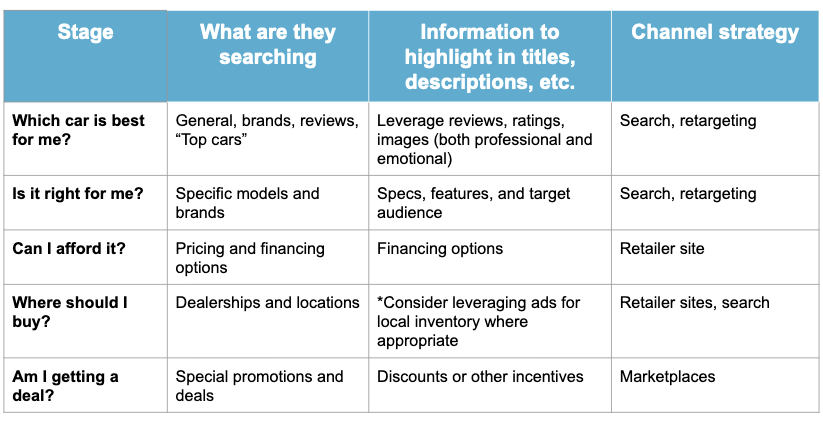Consumers have Tesla-high expectations about the car buying experience. Despite these expectations, businesses often struggle to offer a fully modernized and consistent product experience. One massive hurdle for every business looking to succeed in automotive ecommerce is the proliferation of touchpoints.
When Google examined one car buyer’s journey, they found that the buyer experienced 900+ digital touchpoints before making their purchase. The average is significantly less, at 24 touchpoints, but the fact remains: Capitalizing on these touchpoints requires automotive businesses to engage in dynamic and agile advertising__.
Automotive marketers typically have to juggle products that have a huge number of unique and varied specifications - and this can be particularly complex.
Dynamic advertising can help dealers, sellers, and automotive marketers of all kinds reach more customers and sell more. Here’s how to get started (plus some powerful tips for leveraging Google and Facebook).
What are dynamic ads for automotive?
Dynamic ads combine a business’s product catalog with user information like search history and demographics in order to deliver a completely relevant and targeted ad. Imagine one of your possible customers out there in the wild. They haven’t yet purchased from you. They’re googling for price comparisons of a particular car type or car part. They click an ad for cars similar to what you sell.
Because you use platforms like Google and Facebook to advertise, you’re able to automatically locate and target this user (and thousands of others like them). The result is a well-oiled, modern marketing machine.
One great benefit of dynamic advertising is that businesses are able to make messaging more personalized, pairing concrete and granular model information with in-depth user details, and reach shoppers on a huge scale.
Dynamic advertising reflects the needs of automotive ecommerce today
Deloitte found that most shoppers spend less than one month researching vehicles before making a purchase. Plus, shoppers tend to buy within one week of their first dealership visit. If you’re not able to reach users quickly and precisely in the (very) early shopping stages, you risk losing out to competitors who are more agile.
Key channels for marketing
Depending on what you’re advertising, your roadmap will look a little different. Ideally, you’ll be on dozens of channels. Below are some of the popular examples for automotive ecommerce, particularly in the US.

Regardless of where you send your product information, there are two channels each automotive business should be on top of: Facebook and Google. These not only have a large audience, they also have the analytics and insights on consumers, which makes retargeting more effective.
Note: Marketplaces are also crucial! While these touchpoints aren’t usually dynamic, marketplaces like Amazon, eBay, Commision Junction, Bonanza, and local or regional marketplaces could be a powerful link to many consumers.
Facebook dynamic ads & Facebook automotive inventory ads
Millenials and Gen Z are set to account for 75% of car sales by 2025, and Facebook is their social platform of choice. Facebook’s dynamic ads are the go-to tool for dynamically advertising products on Facebook.
| Good for | Retargeting and locating new audiences; connecting with users on a personal and emotional level; driving site visits as well as online and offline sales. |
| For dealers | Automotive inventory ads enable marketers to leverage their automotive product inventory to create compelling ads across Facebook and Instagram.
Facebook’s Store Traffic objective can also be used in addition to dynamic ads to drive user directly to a specific brick-and-mortar location. |
Tips:
|
|
Google Shopping + local inventory ads
Twice as many vehicle buyers start their research online versus at a dealer - and Google is their go-to platform for initial research. Google Shopping ads are the basic advertising format.
| Good for | Reaching users making relevant searches; helping users find relevant product information; driving site visits as well as online and offline sales. |
| For parts and OEM | Google automotive ads can be used to advertise in relation to searches for automotive makes and models. They feature large images and are built for highlighting automotive specifications. |
| For dealers | Google Dealer Automotive ads allow dealers to create actionable ads for nearby dealerships to display at the top of mobile search results.
Google Local Inventory ads can be used to drive users to a specific brick-and-mortar location by leveraging data like current inventory and promotions. |
Tips:
|
|
How to align your product information with different customer journey stages
Now you should have an idea of how and where to reach your target audience. But what do you say when you find them? Start by considering their place in the buying process.
There are five main stages involved. Try to tailor product content and efforts according to these steps. For example, when retargeting to a lead far down the funnel via Facebook, you might show a local dealership with the exact car model in question.

Tailoring and distributing product content at scale for more powerful automotive ecommerce
Automotive product content is complicated, and it can include all kinds of specifications and unique attributes. That's why product content management and distribution are the backbone of your online efforts. Whether it’s a marketplace, retailer, or nurturing platform, the data needs to be carefully tailored and distributed to each channel.
In order to tailor and distribute at scale, you’ll need to replace manual processes with automation. This can only be done by integrating the right solution. With Productsup, you can master the complete flow of your product content, from beginning to end, and ensure that every channel is populated with top-notch information.
Use Productsup to:
- Standardize and completely optimize product content in bulk
- Distribute content to all the right channels, at the right times
- Dynamically generate images with key product features
- Automate manual processes, coding-free (no IT required)
- Fetch and merge product data easily, no matter where it's stored

![[WP Import] How to succeed in automotive ecommerce with dynamic advertising](http://images.ctfassets.net/q17uls4wkkdz/3lRaGE6N4pqbKVzMQMFWtK/2012a021763763c51b2da6427c8696af/19-09-05_How_to_leverage_dynamic_advertising_and_succeed_in_automotive_ecommerce_Ft_Image_800x500.png?w=1200&h=675&fit=FILL)